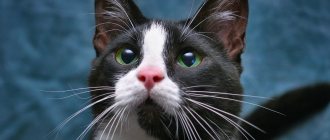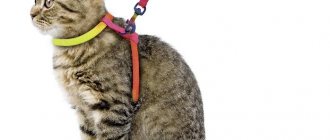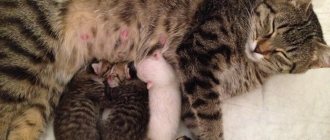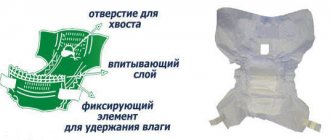Everyone knows that cats are excellent at finding their way in the dark. But contrary to popular belief, this is not connected with the ability to see, but with the ability to feel. And the mustache plays the main role in this. Whiskers, or rather vibrissae (from the Latin vibro, I wriggle, oscillate) are not only an attribute and decoration of a cat’s face, but also the main organ of touch.
A kind of receptor that has changed in the long process of evolution. Vibrissae give the animal all the necessary information about the surrounding world, help it navigate in the dark, hunt, notice the smallest changes in the environment, and even sense changes in atmospheric pressure. It is not without reason that many folk signs are associated with cats.
The difference between a mustache and hair
Cat whiskers, although they are the closest relatives of hair, have many anatomical and functional differences.
The vibrissa shaft, its outer part, differs primarily in length and stiffness compared to other hair. The root of the sensitive antennae is located in the superficial layer of the skin, in the follicle. This is where the fun begins.
The vibrissae are well supplied with blood, their root is located directly in the blood vesicle, the so-called sinus, and is surrounded by mechanoreceptors and tens of thousands of nerve endings that detect the slightest movement of the hair and transmit information to the brain. Where, it is worth saying, each vibrissa has its own place. The coordinated work of the striated muscles allows you to move your mustache.
Features of the structure of whiskers in cats and cats
There are no differences in the structure of the vibrissae in cats and male cats. This organ is not related to the gender of the animal and performs the same functions. The difference may be slight in length and thickness. But this is determined solely by genetics.
Locations
There is a common belief that cats have whiskers only on their faces. Long, thick hairs have been seen and known by everyone here. They are located:
- around the nose;
- on the lip pads;
- above the eyes;
- on the lower jaw, more precisely, on the chin.
But there are the same ones on the front legs. True, they are not so noticeable. But just look closely at the paw just above the place where the dewclaw is located, and you can easily spot them.
Vibrissae are located not only on the face, but also on the cat’s paws
Length
The length of the whiskers on a cat's face is on average 5–7 cm. But in this matter, much depends on the breed. So, the owners of the longest mustaches are Maine Coons. Their whiskers add incredible charm to their already charismatic appearance. In sphinxes, on the contrary, the vibrissae are very short, and often also curled. The owners of curly mustaches are cats that carry the Rex gene. The name of these breeds contains the prefix “Rex”. For example: Cornish Rex, Devon Rex and others.
The length of the whiskers is also determined by the cat’s nutrition. If it is balanced, the mustache will be truly luxurious.
There is a popular belief that the longer a cat's whiskers, the more mice he catches. So our ancestors considered this relationship.
Thickness
The thickness of the whiskers varies only by gender: cats have thicker whiskers than cats. You can also identify differences by location:
- the mustache on the cheeks is much thicker than above the eyes;
- on the front legs the vibrissae are only slightly ahead in thickness of the animal's guard hairs.
In general, the thickness of the vibrissae is explained by the fact that the place where each hair grows is rich in nerve endings. And if you consider that their number is quite large, then it becomes clear why the vibrissae has a tubercle at the base.
Other structural features
The vibrissae themselves are already a very mysterious organ. Each hair has a connection with its own part of the brain and is responsible only for a specific function. Therefore, if a cat loses one of its antennae, it temporarily experiences problems in hunting, coordination, touch, etc.
Each antennae is equipped with nerve endings and has its own “representation” in the brain
Photo gallery: mustachioed cats
Maine Coon is a breed characterized by the length of its whiskers
Don Sphynxes are allowed small curled antennae
For some cats, whiskers are not only a necessity, but also a decoration.
Fluffy cats have whiskers to match them
From the mustache straight to the brain: how do they work?
It is interesting that the information that comes from the sensitive mustache and from the eyes goes through one channel - the ternary nerve.
This allows the brain to summarize signals, process them and create a three-dimensional picture of the world around us. Depending on the lighting, the pupil tends to expand or contract. In complete darkness, it is maximally expanded, meaning it has difficulty focusing on nearby objects. The mechanoreceptors, which are located at the base of the mustache, do not need light; they only pick up the vibration of the hair from air currents. This allows you to determine the location and distance to an object and avoid obstacles in time, even in complete darkness.
The very first hairs that kittens develop in the womb are vibrissae.
As we know from school physics courses, air not only never stands still, but also changes its direction when colliding with an object. Sensitive vibrissae are capable of recreating a clear picture of the surrounding environment based on air movement data. For this reason, it is impossible to approach a cat unnoticed.
She may not see or hear you, but she catches the reflected air flow. The only way to catch the animal by surprise is to approach from downwind.
Vibrissae in cats in the wild
By nature, a cat is, first of all, an excellent hunter; as they say, it’s in her blood. And here the mustache plays an important role. Thanks to them, a cat can close its eyes at the right moment to protect them from a branch or blade of grass while making its way through thickets and bushes. And then continue the hunt without taking your eyes off the victim. When prey is caught, the predator holds it in its teeth out of sight. At this moment, only the outstretched mustache helps to assess the situation and control the victim’s behavior.
Confident cat jumps are accomplished solely thanks to the vibrissae. By moving them, the cat determines the direction and speed of the wind, this allows it to adjust the force of the push and the position of the body in the jump.
Worn out or broken vibrissae are restored regardless of molting. This once again emphasizes their incredibly important role in a cat’s life.
Particularly long and coarser hairs can be seen throughout the coat. They are much softer and do not play such a significant role as a mustache, but they also have some sensitivity. These hairs help the cat determine the nature of touches and distinguish between dangerous and pleasant contacts.
When meeting a cat, you can easily determine its attitude towards you. Interest, curiosity and friendliness if the mustache is directed forward. But if the animal presses them to its muzzle, then it is better to hold off on stroking, the cat is aggressive. The movement and location of the whiskers is a kind of “gesture language” of these animals.
The role of whiskers in the life of a cat
If the whiskers are trimmed, the cat will experience discomfort. The animal's perception of the world and orientation deteriorate. The brain does not receive enough necessary information about the world around it. The animal does not orient itself in space, gets stuck in passages, does not orient itself in the room, and often falls.
It is difficult for street animals without vibrissae, as they cannot fully hunt, experience problems with nutrition, and are easily injured. A cat without whiskers loses coordination, may fall from a height, and fail to calculate the jump.
Important: Under no circumstances should you trim your cat’s whiskers. Trimming the whiskers is permissible if the area of the skin on which they are located is infected in any way. The procedure is carried out by a veterinarian who has previously treated the area of skin.
Fortunately for cats, whiskers tend to grow back. This is only if the hair follicle is not damaged. Vibrissae change (fall out and grow again) in 2-3 weeks.
Damage to a cat's whiskers: consequences
A cat's whiskers (vibrissae) are a unique navigation system, damage to which leads to difficulties in orientation.
An animal with damaged or broken whiskers may bump into obstacles, and failure to close its eyes or project a jump can lead to disastrous consequences. Difficulties arise in correctly assessing the size of the hole; the cat may even get stuck. Therefore, if the whiskers are severely damaged, it is recommended to keep the animal at home for several months and not expose it to the risk of injury.
Why does a mother cat chew off her kittens' whiskers?
Sometimes you can see a mother cat chewing off the antennae of small kittens. Why this happens is not yet known for certain. Some experts suggest that in this way, the cat is trying to protect its children from excessive curiosity and leaving the nest too early. After 5-6 months, when the antennae grow, the kitten will be able to fully explore the world around him.
What about hairless cats?
Many will ask, what about the sphinxes? Indeed, in this hairless breed, the whiskers are most often completely absent or represented by small curled antennae. But what’s interesting is that the animals navigate and hunt no worse than those with luxurious mustaches. Whether this yet another cat mystery will ever be solved, time will tell.
If your mustache falls out
Loss of whiskers may indicate the presence of the following problems:
1. Skin diseases. In this case, by the loss of whiskers, one can judge whether the animal has diseases such as ringworm or atopic dermatitis. 2. Fungal diseases. In this case, the affected area of the cat's skin becomes itchy and itchy. 3. The presence of parasites in the body. The coat deteriorates due to metabolic disorders, helminthic infestations, and also when infected with fleas or ticks. 4. Endocrine diseases such as hypothyroidism. If they occur, the hair becomes matted and falls out. 5. Folliculitis is inflammation of the follicles. It is caused by bacteria, fungi, and viruses.
Problems with whiskers in cats and kittens
Whiskers are not only an organ that helps a cat in its difficult life as a predator, it is also a good signal of health problems. Whisker problems reduce a cat's quality of life. Therefore, it is necessary to monitor the condition of the vibrissae and take timely measures to eliminate all kinds of troubles that may affect them.
Fragility
Mustache fragility occurs due to certain deviations in the environment. For example, dry indoor air leads to hair drying out and breaking off. The cat's whiskers are affected in exactly the same way by the lack of fresh water in a cat and, as a consequence, insufficient fluid intake. Frequent bathing also has a negative effect on the elasticity of the antennae. If you also use a low-quality product, the result will not be long in coming.
Broken whiskers can be a sign of insufficient fluid intake by the animal.
The solution to these problems is obvious:
- normalization of humidity (if the pet lives in an apartment);
- availability of fresh water;
- using quality hair care products.
Dropping out
Losing a mustache is a more serious signal than breaking it off. If fragility is mainly affected by the environment, then hair loss is caused by health problems.
Loss of whiskers often accompanies allergic reactions in cats. Allergies in a pet usually occur to food, most often to milk and fish. Associated symptoms are clearly visible:
- hair loss;
- lacrimation;
- stool disorders.
When faced with whisker loss, you should pay attention to your cat's diet.
Vitamin deficiency also causes massive loss of mustaches. It occurs against the background of a monotonous diet, which causes a deficiency of important microelements and vitamins.
Infestation with parasites is another important factor. The fact is that the waste products of helminths are very toxic. They can cause allergies even in humans, even to the point of Quincke's edema, to say nothing of cats. Intoxication of the body leads to a poor supply of nutrients to the hair follicle in which the vibrissa is located, which leads to its death and loss. Some cats are allergic to flea saliva, which can also cause whiskers to fall out.
A fungal infection of the skin, which causes peeling and itching, also signals its appearance by the loss of vibrissae.
To solve these problems, you need to contact a veterinarian as soon as possible, who will prescribe treatment.
Poor growth
Poor whisker growth depends primarily on the general condition of the cat. The quality of food, the presence of vitamins and microelements, good coat care - all this is directly related to the growth of not only the whiskers, but also the animal itself. Poor mustache growth can also be caused by endocrine problems and metabolic disorders.
If improving the quality of keeping a cat does not lead to a positive result, consultation with a specialist is necessary.
What does the absence of a mustache lead to?
The loss of a cat's whiskers directly affects not only its mood, but also its behavior and life in general. As mentioned earlier, the whiskers in cats are directly connected to the nerve endings, and this has a certain impact on the character of the cat that is forced to live without a whisker.
With the absence of whiskers, cats, of course, do not die, but, nevertheless, they are deprived of an important sensory organ. Many actions, such as hunting, navigation, movement, become much more difficult to perform. In this regard, when a cat loses its whiskers, it becomes lost, nervous, and aggressive. Until the whiskers grow back (this is a rather long process), she is in constant stress, and this is very harmful to the health of the animal. So, cats without whiskers have a very difficult life psychologically.
© shutterstock
Why do cats' whiskers break?
The vibrissae fall out as they wear out. They are replaced by new, stronger mustaches. This process is not associated with the natural molting of the animal. Therefore, it is necessary to distinguish the renewal of tactile hairs from pathological hair loss.
Table 2. Possible loss options
| Causes | Description |
| Curiosity | Often cats are left without whiskers due to carelessness - by coming close to a fire, for example. |
| Maternal care | The female bites off the whiskers of the most active babies. This makes kittens less playful and more wary when exploring the outside world. |
| Encounter with other cats | During a fight, alpha males bite off the vibrissae of the enemy in order to prove superiority. |
| Genetic predisposition | Hairless cat breeds are more likely than others to lose their whiskers. The record holders for the loss of whiskers are sphinxes and their hybrids - elves, ambinos and levkoys. |
The Don Sphynx is a typical representative of “vibrisless” breeds
The listed reasons do not require the intervention of the pet owner. However, serious pathologies often act as a provoking factor. In this case, it is necessary to show the animal to a veterinarian.
Table 3. Causes of deterioration of the whiskers
| Causes | Rationale |
| Avitaminosis | Vitamin A deficiency makes mustaches more fragile. A lack of ascorbic acid can impair the synthesis of collagen, a substance that is part of the vibrissae. |
| Allergy | Since allergic reactions in most cases irritate the fur, the tactile whiskers are also at risk |
| Fungal diseases | Affecting the skin and hair, the pathology negatively affects the condition of the mustache. |
| Malfunctions of the endocrine system | Diseases of the thyroid gland often occur against the background of hair loss and tactile whiskers. |
| Skin pathologies | Dermatological diseases - ringworm, for example, are accompanied by loss of both hair and whiskers. |
To determine true whisker loss, a pet owner should consult a veterinarian.
Lack of fluid leads to brittle whiskers











